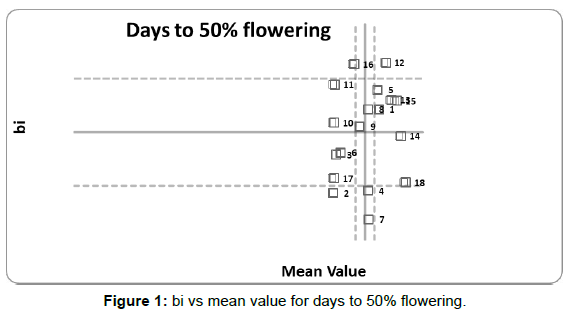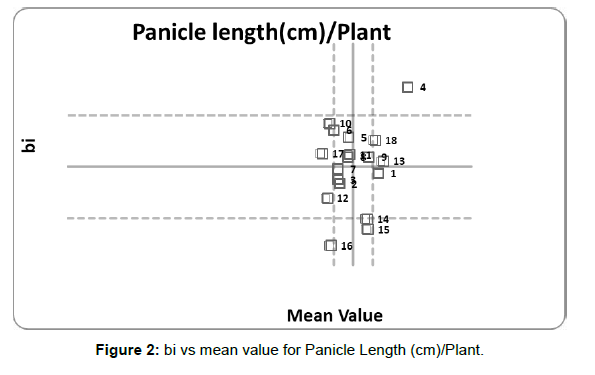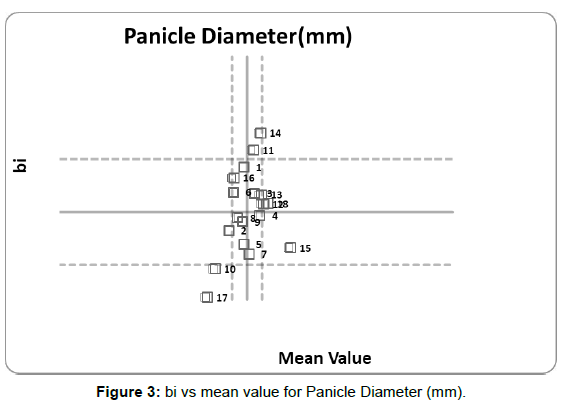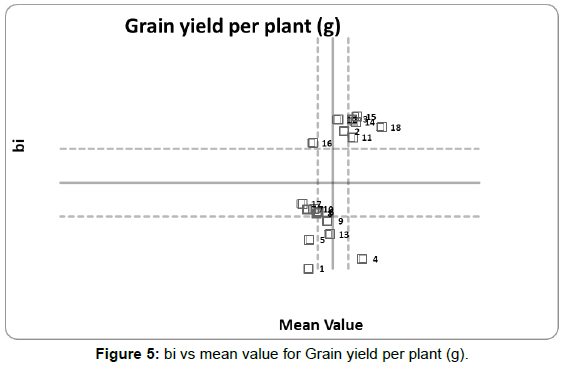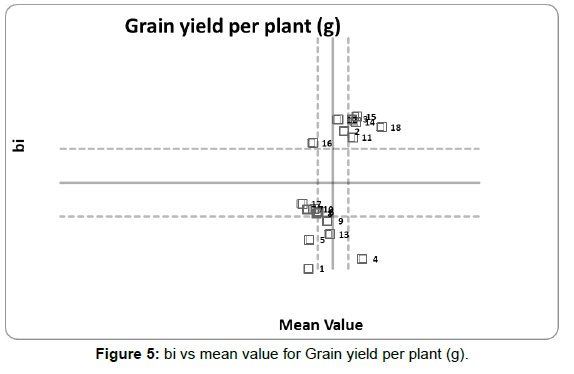Estimation of Stability Performance in Seed Yield and Its Components in Pearl Millet (Pennisetum Glaucum[L.] R. Br) Hybrids of Semi-Arid Eastern Plains of Rajasthan
Received: 02-Apr-2022 / Manuscript No. JPGB-22-59339 / Editor assigned: 06-Apr-2022 / PreQC No. JPGB-22-59339(PQ) / Reviewed: 15-Apr-2022 / QC No. JPGB-22-59339 / Revised: 22-Apr-2022 / Manuscript No. JPGB-22-59339(R) / Accepted Date: 25-Apr-2022 / Published Date: 26-Apr-2022 DOI: 10.4172/jpgb.1000119
Abstract
During kharif 2018, a study on genotype x environment interaction for grain yield in Pearl Millet (Pennisetum glaucum L.) was carried out using a randomized block design with three replications in three artificially created environments having varied doses of fertilizers. A total of eighteen hybrids were chosen to estimate their stability with respect to different morphological characters as well as identify the best hybrid with respect to high yield. The environment indices for all the characters, were found in between -2.85 (environment-III) and 1.76 (environment-I), indicating an enough diversity provided to run the experiment satisfactorily. The average seed yield was found maximum in KBH-108 (30.73g) and minimum in MARU-TEJ (23.17g). Of them, our study has realized MPMH-17as the most stable hybrid followed by HHB-197, and RHB-177 with respect to grain yield in all three different environments. The environments exhibited a linear effect on mean grain yield, with the lowest value under environment-III. In HHB- 197 and MPMH-17, consistent grain production was found in all the environments. Seed yield stability was found below average in RHB-223, HHB-299, and 9001, alluded their need of favorable environmental conditions to perform satisfactorily. Whereas, hybrids RHB-233, HHB-67,GHB-744, and 9450 have shown seed yield stability more than the average value, disseminated their capability to survive even in the difficult climatic conditions.
Keywords
Pearl millet; Stability; Regression coefficient; Environmental indices; Standard deviation
Introduction
Pearl millet [Pennisetum glaucum (L.) R. Br.], popularized as bajra (2n = 14) belongs to the family Poaceae (earlier Gramineae) and is highly cross-pollinated crop with protogynous condition [1]. It is heterogenous as well as heterozygous in nature.In India, pearl millet ranks fourth amongst the most widely cultivated food crop after rice, wheat, and maize. Total cultivable area covers 6.93 million ha throughout the nation and secures 8.61 million tons of annual production and 1,243 kgha−1 of productivity [2]. Pearl millet is thought to be originated in West Africa [3]. Although it is grown all over the world, Nigeria, Pakistan, Sudan, and Saudi Arabia contribute as the major pearl millet growing countries throughout the globe. In India, the major pearl millet growing states are Rajasthan, Maharashtra, Gujarat, Uttar Pradesh and Haryana, covering nearly 90% acre.
In agricultural field, study on Genotype X Environment interaction (GXE) is a common phenomenon. When environment changes, gaps between genotypic values may increase or decrease which may cause genotypes to even rank differently between environments.Stability means stable performance of a hybrid in wide range of environmental condition.Usually, no hybridscanperform equally in all environments due to theirparticular genetic barriers. In adverse conditions,unlike the purelines, hybrids show reduced performance rather than total crop failure. Yield is a complicated attribute, influenced by a number of morphological and physiological characteristics, including maturity, panicle length, panicle diameter, test weight, and so on. As those parameters inherit very simply, their exploitation looks so easy. Many scientific reports have already demonstrated a positive association with the final outcome i.e., seed yield.
Plant breeders have long sought to create genotypes with a wide range of adaptability. A huge range of genotype-environment (G x E) interactions, many a times creates complexities while determining the genetic influence on variability. Plant breeding programs strive to create genotypes that are phenotypically stable and adaptable to a variety of settings. Multi-environment testing aids in the selection of genotypes that excel in terms of yield and other traits.This study looked into G x E interactions for ultimate outcomeas well as important yieldcontributing aspects in pearl millet.
Materials and Methods
For the current study, eighteen hybrids of pearl millet (Table 1) were collected from the Rajasthan Agriculture Research Institute, Durgapura, Jaipur under the supervision of S.K.N.A.U, Jobner. Hybrid seeds werecarefully sownwith proper spacing (45cm × 10cm) in three artificially created environments along with varied doses of fertilizers.
The environments for this study were created using a variety of fertilizer doses in the following manner (Table 2):
| Sr. No. | Number of Hybrids |
|---|---|
| 1 | RHB-173 |
| 2 | RHB-177 |
| 3 | RHB-223 |
| 4 | RHB-233 |
| 5 | RHB-234 |
| 6 | GHB-538 |
| 7 | GHB-558 |
| 8 | GHB-744 |
| 9 | GHB-905 |
| 10 | HHB-67 |
| 11 | HHB-197 |
| 12 | HHB-299 |
| 13 | 9450 |
| 14 | 9001 |
| 15 | 86-M-86 |
| 16 | MCPH-17 |
| 17 | MARU-TEJ |
| 18 | KBH-108 |
Table 1: Hybrids chosen for the current study.
| Sr.No. | Environment | N2(kgha-1) | P2O5(kg ha-1) | K2O (kg ha-1) |
|---|---|---|---|---|
| 1 | E-I (150% D.O.F) | 90 | 45 | 45 |
| 2 | E-II (100% D.O.F) | 60 | 30 | 30 |
| 3 | E-III (50% D.O.F) | 30 | 15 | 15 |
| *D.O.F represents doses of fertilizers | ||||
Table 2: Different environments studied under the current investigation
In each replication, hybrid seeds were sown in two rows in a plot of 4.0 x 0.6 m2. Row to row distance was managed at 45 cm, while two adjacent plants were grown at 10 cm apart. From each plot, ten random plants, excluding the border ones were selected for recording the observations. On the field note book, we have recorded grain yield, days to 50% flowering, panicle diameter, ear length and test weight for each and every representative plants.
The importance of variation owing to variations, environments, and varieties x environments interactionwas compared to pooling error.
Statistical analysis
The data on each character for the variations was subjected to standard statistical analysis of variance for each habitat independently [4]. After that, a pooled analysis of variance was run on the data from each group [5].
Results and discussion
Earliness is a desirable character in kharif crops where erratic rains or lack of rains, particularly in later part is very common. The early hybrids may escape the adversities and mature before the onset of various stresses. This is the reason why breeders prefer early varieties most,despite of the negative correlation between earliness and the grain yield. In the current study, we found the average values of days to 50% flowering ranging from 44.56 (RHB-177) to 57.11 days (KBH- 108) with the regression coefficient in the range of 0.19 (GHB-558) to 1.64 (HHB-299) (Tables 3-5 and Figure 1) and a wide range of environmental indices (-3.50 to 3.01) (Table 3), which reflectimmense difference between the environments created for this character.The S2di values for all the hybrids were found non-significant (Table 5). Of eighteen hybrids, RHB-177 was found best to perform as an early variety followed by HHB-67 and MARU-TEJ (44.78 days to reach 50% flowering). Grain yield per plant was found to have negative association with days to 50% flowering just alike the expounding of one of the researcher.
| Environments | Days to 50% flowering | Panicle length | Panicle diameter | Test weight | Seed yield/plant |
|---|---|---|---|---|---|
| I | -3.5 | 1.95 | 0.09 | 0.84 | 1.764 |
| II | 0.48 | -0.72 | 0.06 | -0.27 | 1.088 |
| III | 3.01 | -1.25 | -0.16 | -0.57 | -2.853 |
| Grand mean | 50.06 | 21.23 | 2.39 | 9.88 | 26.0 |
Table 3: Environment indices for different characters of pearl millet hybrids
Source of variation |
d.f. | Days to 50% flowering | Panicle length (cm) | Panicle diameter (cm) | Test weight (g) | Seed yield/plant (g) |
|---|---|---|---|---|---|---|
| Hybrids | 17 | 56.89** | 9.12 | 0.19* | 1.14** | 14.91** |
| Env. + (Gen.x Env.) | 36 | 15.36* | 6.20 | 0.08 | 0.97* | 13.49** |
| Env. (Linear) | 1 | 388.68** | 107.20** | 0.70** | 19.72** | 223.89** |
| Gen. x Env. (Linear) | 17 | 4.04 | 2.41 | 0.04 | 0.79* | 10.89** |
| Pooled deviation | 18 | 5.32 | 4.17** | 0.07** | 0.11 | 4.25* |
| RHB-173 | 1 | 6.26 | 0.20 | 0.06 | 0.01 | 3.72 |
| RHB-177 | 1 | 0.88 | 0.19 | 0.05 | 0.01 | 0.01 |
| RHB-223 | 1 | 1.05 | 0.52 | 0.01 | 0.13 | 1.62 |
| RHB-233 | 1 | 0.03 | 0.02 | 0.03 | 0.68 | 0.13 |
| RHB-234 | 1 | 4.79 | 1.00 | 0.07 | 0.30 | 0.48 |
| RHB-538 | 1 | 11.28 | 0.66 | 0.01 | 0.17 | 13.29* |
| GHB-558 | 1 | 10.11 | 14.56** | 0.04 | 0.01 | 12.09* |
| GHB-744 | 1 | 18.38 | 2.95 | 0.04 | 0.05 | 1.94 |
| GHB-905 | 1 | 0.58 | 1.79 | 0.07 | 0.17 | 6.27 |
| HHB-67 | 1 | 10.58 | 3.78 | 0.22** | 0.03 | 12.26* |
| HHB-197 | 1 | 2.38 | 1.80 | 0.03 | 0.01 | 7.46 |
| HHB-299 | 1 | 11.88 | 6.70* | 0.21** | 0.05 | 0.05 |
| 9450 | 1 | 6.36 | 6.76* | 0.12* | 0.01 | 2.67 |
| 9001 | 1 | 2.63 | 16.36** | 0.03 | 0.06 | 9.49 |
| 86-M-86 | 1 | 5.07 | 1.22 | 0.02 | 0.03 | 0.46 |
| MPMH-17 | 1 | 2.68 | 1.13 | 0.01 | 0.23 | 3.84 |
| MARU-TEJ | 1 | 0.15 | 0.32 | 0.24** | 0.02 | 0.08 |
| KBH-108 | 1 | 0.60 | 15.04** | 0.07 | 0.01 | 0.70 |
| Pooled error | 102 | 15.52 | 4.26 | 0.06 | 0.81 | 7.46 |
| Total | 53 | 28.68 | 7.14 | 0.11 | 1.03 | 13.94 |
| *, ** = significant at 5% and 1% levels, respectively | ||||||
Table 4: Joint regression analysis for the parameters tested in three different environments
| Days to 50% flowering | |||
|---|---|---|---|
| Hybrids | Mean | bi | S2di |
| RHB-173 | 52.44 | 1.21* | 1.09 |
| RHB-177 | 44.56 | 0.43* | -4.28 |
| RHB-223 | 45.11 | 0.79** | -4.14 |
| RHB-233 | 50.56 | 0.46** | -5.16 |
| RHB-234 | 52.22 | 1.39** | -0.37 |
| RHB-538 | 45.89 | 0.81 | 6.12 |
| GHB-558 | 50.67 | 0.19 | 4.94 |
| GHB-744 | 50.56 | 1.21 | 13.21 |
| GHB-905 | 49.11 | 1.05** | -4.59 |
| HHB-67 | 44.78 | 1.09 | 5.41 |
| HHB-197 | 44.89 | 1.44** | -2.79 |
| HHB-299 | 53.67 | 1.64* | 6.71 |
| 9450 | 54.67 | 1.30* | 1.19 |
| 9001 | 56.22 | 0.97* | -2.54 |
| 86-M-86 | 55.56 | 1.29* | -0.10 |
| MPMH-17 | 48.22 | 1.63** | -2.49 |
| MARU-TEJ | 44.78 | 0.57** | -5.05 |
| KBH-108 | 57.11 | 0.53** | -4.56 |
| S.Em+ | 1.63 | 0.49 | |
| Pop. Mean | 50.61 | 1 | |
| *, ** = significant at 5% and 1% levels, respectively | |||
Table 5: Mean values and stability parameters (bi and S2di) of the Pearl millet hybrids for days to 50% flowering
Harer PN and Karad SR, reported positive association between panicle length (cm) and seed yield per plant (g) in pearl millet. In the present study, mean value of panicle length ranging from 18.95 (MARUTEJ) to 25.26 cm (RHB-233) with the regression coefficient in the range of -0.29 (MPMH-17) to 2.28 (RHB-233) (Table 6) and (Figure 2) and a wide range of environment indices (-1.25 to 1.95) (Table 3), indicating a remarkable distinction among the all environments created. The S2di estimates of all the hybrids were found non-significant except of HHB-299, GHB-558, 9450, 9001 and KBH-108 (Table 6). Many of the hybridshave shown non-significant deviation from regression line for panicle length. Based on mean and regression coefficient, 9001, RHB- 173 and GHB-538 were found most stable among all the hybrids, whereas GHB-905, HHB-67, HHB-197 being found with below average stability looked congruent for improved management practices like high fertility and proper irrigation. High mean and regression coefficient less than 1 in RHB-233, RHB-234 indicate their stability indices exceeding the average value.
The mean panicle diameter ranged from 1.89 (MARU-TEJ) to 2.93 cm (86-M-86). The regression coefficient ranged from -1.21 (MARUTEJ) to 3.02 (9001). The S2di estimates were non-significant for most of the hybrids except HHB-67, HHB-299, 9450, MARU-TEJ (Table 6) and (Figure 3). The environmental indices varied from -0.16 to 0.09 panicle diameter wasfound maximum in 86-M-86 (2.94 cm) followed by HHB-299 (2.59 cm), RHB-233 (2.55 cm), and GHB-744 (2.27 cm) where the bi values were obtained close to 1, indicating their stable performance (Table 6).
| Panicle length (cm) | Panicle diameter (cm) | |||||||
|---|---|---|---|---|---|---|---|---|
| Hybrids | Mean | bi | S2di | Mean | bi | S2di | ||
| RHB-173 | 23.08 | 0.88** | -1.21 | 2.35 | 2.14 | 0.05 | ||
| RHB-177 | 20.21 | 0.73** | -1.22 | 2.15 | 0.53 | 0.02 | ||
| RHB-223 | 20.10 | 0.78* | -0.91 | 2.49 | 1.48** | -0.02 | ||
| RHB-233 | 25.26 | 2.28** | -1.41 | 2.54 | 0.91 | 0.02 | ||
| RHB-234 | 20.92 | 1.47* | -0.41 | 2.33 | 0.16 | 0.04 | ||
| RHB-538 | 19.79 | 1.58** | -0.77 | 2.22 | 1.52** | -0.02 | ||
| GHB-558 | 21.11 | 0.97 | 13.13** | 2.42 | -0.07 | 0.03 | ||
| GHB-744 | 20.85 | 1.15 | 1.54 | 2.26 | 0.86 | 0.01 | ||
| GHB-905 | 22.38 | 1.17 | 0.38 | 2.34 | 0.74 | 0.06 | ||
| HHB-67 | 19.50 | 1.71* | 2.37 | 1.99 | -0.45 | 0.21** | ||
| HHB-197 | 21.02 | 1.21* | 0.39 | 2.46 | 2.58** | 0.02 | ||
| HHB-299 | 19.31 | 0.48 | 5.27* | 2.60 | 1.21 | 0.20** | ||
| 9450 | 23.49 | 1.10 | 5.35* | 2.58 | 1.43 | 0.09* | ||
| 9001 | 22.29 | 0.16 | 14.93** | 2.57 | 3.02** | 0.01 | ||
| 86-M-86 | 23.35 | -0.02 | -0.20 | 2.93 | 0.09 | 0.02 | ||
| MPMH-17 | 19.59 | -0.29 | -0.29 | 2.21 | 1.88** | -0.02 | ||
| MARU-TEJ | 18.95 | 1.22** | -1.11 | 1.89 | -1.21 | 0.23** | ||
| KBH-108 | 22.90 | 1.42 | 13.63** | 2.64 | 1.23 | 0.05 | ||
| S.Em+ | 1.44 | 0.83 | 0.19 | 1.36 | ||||
| Pop. Mean | 21.22 | 1 | 2.38 | 1 | ||||
| *, ** = significant at 5% and 1% levels, respectively | ||||||||
Table 6: Mean values and stability parameters (bi andS2di) of the pearl millet hybrids for panicle diameter and panicle length (cm)
The test weight ranged from 8.69 (RHB-173) to 10.62 (GHB-744). The regression coefficient ranged from -0.55 (9001) to 2.61(RHB-223). The S2di estimates were all the hybrids were non- significant (Table 7 and Figure 4). The environmental indices ranged from -0.57 to 0.84 (Table 3), indicating differences among the environments. Irshad-ulhaq M [7] reported positive correlation between test weight and seed yield per plant, hence high mean of test weight is desirable. The S2di estimates of most of the hybrids for test weight were non- significant. Because of high mean in 86-M-86 (10.51), RHB-538 (10.31 g), and RHB-234 (9.43 g) along with regression coefficient close to 1, these have been considered as stable for test weight.
The average seed yield per five plants ranged from 23.17 (RHB-173) to 30.73 g (KHB-108). The regression coefficient ranged from -0.49 (RHB- 173) to 2.14 (86-M-86) (Table 7 and Figure 5). The environment indices ranged from -2.85 to 1.76 (Table 3), reflecting noticeable differences among the environments created. The S2di associated with most of the hybrids were non-significant barring HHB-67, GHB-744, RHB-538 (Table 7).
Test weight (g) |
Seed yield/plant (g) | |||||
|---|---|---|---|---|---|---|
| Hybrids | Mean | bi | S2di | Mean | bi | S2di |
| RHB-173 | 8.69 | 2.34** | -0.27 | 23.71 | -0.49 | 1.23 |
| RHB-177 | 9.39 | 1.22** | -0.27 | 27.09 | 1.89** | -2.49 |
| RHB-223 | 9.56 | 2.61** | -0.14 | 27.86 | 2.10** | -0.87 |
| RHB-233 | 8.95 | 1.47 | 0.41 | 28.84 | -0.32 | -2.36 |
| RHB-234 | 9.43 | 1.06 | 0.03 | 23.80 | 0.01 | -2.01 |
| RHB-538 | 10.31 | 1.10* | -0.10 | 24.65 | 0.49 | 10.80* |
| GHB-558 | 10.06 | 0.57** | -0.26 | 23.61 | 0.54 | 9.60* |
| GHB-744 | 10.62 | 0.40 | -0.24 | 24.51 | 0.47 | -0.55 |
| GHB-905 | 10.55 | 1.11* | -0.11 | 25.51 | 0.33 | 3.78 |
| HHB-67 | 10.17 | 0.75** | -0.23 | 24.26 | 0.54 | 9.77* |
| HHB-197 | 10.17 | 0.22** | -0.27 | 27.99 | 1.78* | 4.97 |
| HHB-299 | 10.09 | 0.68** | -0.22 | 26.59 | 2.09** | -2.44 |
| 9450 | 10.27 | 1.61** | -0.27 | 25.78 | 0.11 | 0.18 |
| 9001 | 9.51 | -0.55 | -0.21 | 28.28 | 2.05* | 7.00 |
| 86-M-86 | 10.51 | 1.25** | -0.24 | 28.36 | 2.14** | -2.03 |
| MPMH-17 | 8.84 | -0.44 | -0.03 | 24.19 | 1.69** | 1.35 |
| MARU-TEJ | 10.15 | 1.36** | -0.26 | 23.17 | 0.63** | -2.41 |
| KBH-108 | 10.50 | 1.27** | -0.28 | 30.73 | 1.96** | -1.79 |
| S. Em+ | 0.23 | 0.31 | 14.538 | 0.584 | ||
| Pop. mean | 9.87 | 1 | 26.05 | 1 | ||
| *, ** = significant at 5% and 1% levels, respectively | ||||||
Table 7: Mean values and stability parameters (bi and S2di) of the pearl millet hybrids for test weight (g) and seed yield (g)
For all parameters, an environment-by-environment analysis of variance revealed substantial differences between hybrids in each environment. For all of the characters, the pooled analysis revealed substantial differences across the hybrids, demonstrating that actual differences exist between hybrids. For all of the qualities that are comparable to the vast range of environmental indicators, the environmental influence was likewise extremely significant. This suggested that the surroundings had a significant impact on hybrid performance. Except for days to 50% blooming and panicle length, genotype x environment interactions were significant for the majority of the characteristics, hence stability parameters were determined for all of them. Except for plant height, panicle length, and panicle diameter, the environment plus genotype x environment interactions were significant for the majority of the traits (Table 4). The linear component of the G x E interaction was significant for test weight and seed yield per plant, indicating that hybrids had divergent linear responses to environmental changes for these characters, according to stability analysis by joint regression analysis [8]. The pooled deviations for panicle length, panicle diameter, and seed yield per plant were found so significant (Table 4), that indicate that departures from linear regression also contributed significantly to the variations in hybrid stability for these traits.
The hybrids RHB-177, HHB-197, and MPMH-17 were found to be stable for the majority of the traits, making them suited for everchanging environmental circumstances.
A stable genotype according to Eberhart and Russell [8] is one which has the regression coefficient (b) equal to unity (bi = 1.0) and deviation not significantly different from zero (S2di =0).
References
- Animasaun DA, Morakinyo JA, Krishnamurthy R (2019) Genome size and ploidy variations in pearl millet (Pennisetum glaucum) and napier grass (Pennisetum purpureum) genotypes. Acta Agronómica 68.
- Directorate of Millets Development (2020) Status paper on coarse cereals (Sorghum, Pearl millet, Finger millet, small millet, Maize and Barley). Department of Agriculture & Cooperation, Ministry of Agriculture, Government of India, India.
- Vavilov NI (1951) The origin, variation, immunity and breeding of cultivated plants. Soil Sci 72: 482.
- Panse VG, Sukhatme PV (1985) Statistical methods for agriculture workers. Indian Council of Agriculture Research, New Delhi 87-89.
- Singh RK, Chaudhary BD (1985) Biometrical methods in Quantitative Genetic Analysis. Kalyani Pub, Ludhiana, New Delhi. Revised Ed. 318.
- Kulkarni VM, Navale PA, Harinarayana G (2000) Variability and path analysis in white grain pearl millet [Pennisetum glaucum (L.) R. Br.]. Tropical Agriculture 77: 130-132.
- Irshad-ul-haq M, Saeeda K, Muhammad S, Naveed K (2015) Correlation and heritability studies in pearl millet. Int J Biol12: 81-83.
- Eberhart SA, Russell WA (1966) Stability parameters for comparing varieties. Crop Sci 6: 36-40.
Citation: Kumar A, Mondal K, Singh D, Yadav MK, Kumhar GL (2022) Estimation of Stability Performance in Seed Yield and Its Components in Pearl Millet (Pennisetum Glaucum[L.] R. Br) Hybrids of Semi-Arid Eastern Plains of Rajasthan. J Plant Genet Breed 6: 119. DOI: 10.4172/jpgb.1000119
Copyright: © 2022 Kumar A, et al. This is an open-access article distributed under the terms of the Creative Commons Attribution License, which permits unrestricted use, distribution, and reproduction in any medium, provided the original author and source are credited.
Select your language of interest to view the total content in your interested language
Share This Article
Open Access Journals
Article Tools
Article Usage
- Total views: 3380
- [From(publication date): 0-2022 - Dec 06, 2025]
- Breakdown by view type
- HTML page views: 2752
- PDF downloads: 628

